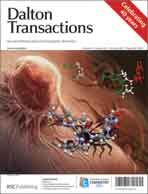The calix[4]arene-imidazolium salts 5-(3-butyl-1-imidazolylium)-25,26,27,28-tetrabenzyloxy-calix[4]arene bromide (cone) (2), and 5,11-bis(3-alkyl-1-imidazolylium)-25,26,27,28-tetrabenzyloxycalix[4]arene diiodide (cone) (R = methyl, 3a; R = n-butyl, 3b) have been synthesised. Reaction of 2 in dioxane with PdCl2 in the presence of CsCO3 and KBr (80 °C, 24 h) gives the carbene complex trans-[PdBr2(calix-monocarbene)2] (14), containing two N-heterocyclic carbene ligands derived from 2 (yield: 63%). Repeating the reaction in pyridine instead of dioxane gives the mixed pyridine-carbene complex trans-[PdBr2(calix-carbene)(pyridine)] (15) in 75% yield. Treatment of the bis-imidazolium salt 3a with [Pd(OAc)2] affords a chelate complex, trans-[PdI2{calix-bis(carbene)}] (16), in which a metallo-(bis-carbene) fragment caps the upper rim of the calixarene basket. Complex 16, as well as its analogue 17, obtained from 3b, display apparent Cs-symmetry in solution. This is not the case in the solid state, a single X-ray diffraction study carried out for 16 revealing a pinced cone structure for the calixarene skeleton, which reduces the symmetry to C1. The chelate complex 17 shows poor activity in Suzuki–Miyaura cross-coupling of phenyl boronic acid and p-tolyl halides, an observation that suggests the presence of a strained metallocyclic unit preventing easy stereochemical rearrangement to an active species. Unlike 17, complexes 14 and 15 show good activities in cross-coupling. A comparative study using the carbene precursor 1-butyl-3-(2,6-diisopropylphenyl)imidazolium bromide (18), which is devoid of the receptor fragment, strongly suggests that the carbene ligands of 14 and 15 operate typically as bulky NHC-ligands.
![Graphical abstract: Calix[4]arenes with one and two N-linked imidazolium units as precursors of N-heterocyclic carbene complexes. Coordination chemistry and use in Suzuki–Miyaura cross-coupling](/en/Image/Get?imageInfo.ImageType=GA&imageInfo.ImageIdentifier.ManuscriptID=C1DT10838G&imageInfo.ImageIdentifier.Year=2011)

 Please wait while we load your content...
Please wait while we load your content...